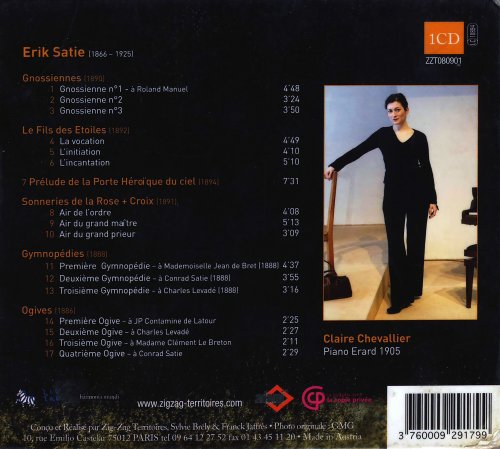
Claire Chevallier - Erik Satie: Le Fils des Etoiles; Sonneries de la Rose + Croix; Gymnopédies (2008)
BAND/ARTIST: Claire Chevallier
- Title: Erik Satie: Le Fils des Etoiles; Sonneries de la Rose + Croix; Gymnopédies
- Year Of Release: 2008
- Label: Zig Zag Territoires
- Genre: Classical, Modern, Impressionism, Piano
- Quality: FLAC (tracks+.cue,log,scans)
- Total Time: 1:07:15
- Total Size: 219 MB
- WebSite: Album Preview
Tracklist:
Erik Satie (1866-1925)
Gnossiennes (1890)
01. No. 1
02. No. 2
03. No. 3
Le Fils des Étoiles (1891)
04. La vocation
05. L'initiation
06. L'incantation
07. Prélude de la Porte Héroïque du ciel (1894)
Sonneries de la Rose + Croix (1892)
08. Air de l'ordre
09. Air du grand maître
10. Air du grand prieur
Gymnopédies (1888)
11. Première Gymnopédie
12. Deuxième Gymnopédie
13. Troisième Gymnopédie
Ogives (1889)
14. Première Ogive - à JP Contamine de Latour
15. Deuxième Ogive - à Charles Levadé
16. Troisième Ogive - à Madame Clément Le Breton
17. Quatrième Ogive - à Conrad Satie

Erik Satie (1866-1925)
Gnossiennes (1890)
01. No. 1
02. No. 2
03. No. 3
Le Fils des Étoiles (1891)
04. La vocation
05. L'initiation
06. L'incantation
07. Prélude de la Porte Héroïque du ciel (1894)
Sonneries de la Rose + Croix (1892)
08. Air de l'ordre
09. Air du grand maître
10. Air du grand prieur
Gymnopédies (1888)
11. Première Gymnopédie
12. Deuxième Gymnopédie
13. Troisième Gymnopédie
Ogives (1889)
14. Première Ogive - à JP Contamine de Latour
15. Deuxième Ogive - à Charles Levadé
16. Troisième Ogive - à Madame Clément Le Breton
17. Quatrième Ogive - à Conrad Satie
The aim of this rather challenging disc, according to pianist Claire Chevallier in her erudite, thoughtful, and yet entertaining booklet notes, is to demonstrate "the existence of a continuous line of thought in Satie's life." The line of thought under discussion is Satie's unorthodox spirituality, which was by all accounts closely linked to his music, and which took various forms during the first part of his career. The music on the program is all drawn from that time period, although it is not chronologically organized; the program ends with the very early Ogives (1886). Satie flirted with Rosicrucianism (in a distinctive Parisian sect also attractive to Debussy) but loved to visit Notre-Dame. Later he founded a single-member church of his own, which he called the "Eglise Métropolitaine d'Art et de Jésus Conducteur." The musical counterparts to these ideas were stark harmonies and modal tunes derived from Satie's studies of chant and medieval music. Chevallier takes these pieces as a group and realizes their commonalities in an unusual way. She uses a 1905 Erard piano, gleaming like a jewel in a period postcard reproduced in the booklet. Its most striking characteristic is the vivid set of harmonics that appear in rhythmically spare passages, intensified by Chevallier's liberal use of the pedal. She takes slow tempos, uses the piano to create kaleidoscopic colors in seemingly simple lines, and generally weaves a hypnotic spell. Sample the "Air du grand maître" from the Sonneries de la Rose + Croix (track 9) for one of the most complicated sets of sounds anyone has ever generated from a passage of bare octaves. Even the best-known work on the program, the set of three Gymnopédies (tracks 11-13), is subjected to this kind of treatment; even though these pieces aren't usually grouped with the others, Chevallier makes a good case for doing so. The disc as a whole is murky, incantatory, and, as Chevallier points out, quite rigorous in its way; her readings are strikingly detailed. They certainly don't represent the last word on Satie: any and all of the remarks Chevallier quotes in the booklet could be taken as humorous, and humor is a strand in Satie's thinking that finds little representation here. Nevertheless, one way to evaluate a Satie disc is to see how much it gets to the sheer weirdness of the man, and by that measure this album ranks near the top of the list. The cooperation of the sound engineers of the French label Zig Zig Territoires is close and absolutely praiseworthy.

Classical | FLAC / APE | CD-Rip
As a ISRA.CLOUD's PREMIUM member you will have the following benefits:
- Unlimited high speed downloads
- Download directly without waiting time
- Unlimited parallel downloads
- Support for download accelerators
- No advertising
- Resume broken downloads


